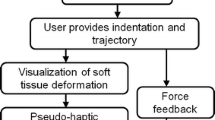Abstract
Purpose
Accurate staging of lymph nodes relies mainly on surgical exploration and manual palpation. We present a new non-invasive diagnostic approach: simulated palpation through virtual laparoscopic instruments.
Methods
We set up a diagnostic process to extract lymph nodes shape and position from CTs and to analyze the trend of pixels intensities to determine tissue properties in order to feedback the force information.
Results
We have integrated the model, obtained from both the morphological information and stiffness values, in our laparoscopy simulator and surgeons can virtually palpate, with a haptic device, the lymph nodes. We evaluated the workflow extracting lymph nodes from a case study: the feedback provided through the simulator greatly helps the surgeon in the correct staging.
Conclusions
Results show the feasibility of the approach and in the future we will clinically evaluate this new diagnostic methodology. We are studying the possibility to integrate CTs with other imaging systems to increase the accuracy.
Similar content being viewed by others
References
Ahuja A, Ying M (2003) Sonography of neck lymph nodes. Part II. Abnormal lymph nodes. Clin Radiol 58: 359–366
Botturi D, Pizzorni Ferrarese F, Zamboni GA, Zerbato D (2008) Preoperative non-invasive staging of lymph nodes. In: Proceedings of CARS 2008, Barcelona, Spain
Commowick O, Grégoire V, Malandain G (2008) Atlas-based delineation of lymph node levels in head and neck computed tomography images. Radiother Oncol 87(2): 281–289
Dornheim J, Seim H, Preim B, Hertel I, Strauss G (2006) Segmentation of neck lymph nodes in CT datasets with stable 3D mass-spring models. In: Proceedings of medical image computing and computer-assisted intervention (MICCAI), Copenhagen, Denmark. Lecture notes in computer science, pp 478–485
Grammalidis N, Strintzis M (2000) Head detection and tracking by 2D and 3D ellipsoid fitting. In: CGI’00: Proceedings of the International Conference on Computer Graphics, Geneva, Switzerland, pp 221–226
Harisinghani M, Weissleder R (2004) Sensitive, noninvasive detection of lymph node metastases. PLOS Med 3034: 265–273
Honea D, Ge Y, Snyder W et al (2004) Lymph node segmentation using active contours. In: Proceeding of SPIE medical imaging, San Diego, CA, USA, vol 3034, pp 265–273
Ilias I, Sahdev A, Reznek R et al (2007) The optimal imaging of adrenal tumours: a comparison of different methods. Endocr Relat Cancer 14(3): 587–599
Jain A, Zhong Y, Dubuisson-Jolly M (1998) Deformable template models: a review. Signal Processing 71(2): 109–129
Kitasaka T, Tsujimura Y, Nakamura Y et al (2007) Automated extraction of lymph nodes from 3D abdominal ct images using 3-d minimum directional difference filter. In: Proceedings of medical image computing and computer-assisted intervention (MICCAI). Lecture notes in computer science, Brisbane, Australia, vol 4729, pp 336–343
Koch M, Gross M, Carls F et al (1996) Simulating facial surgery using finite element models. In: Computer graphics, annual conference series, vol 30, pp 421–428
Lee J, Paik Y, Lee J et al (2006) Candidates for curative resection in advanced gastric cancer patients who had equivocal para-aortic lymph node metastasis on computed tomographic scan. Ann Surg Oncol 13: 1163–1167
Machi J, Staren E (2004) Ultrasound for surgeons. Lippincott Williams & Wilkins, Baltimore
Maleike D, Fabel M, Tetzlaff R et al (2008) Lymph node segmentation on CT images by a shape model guided deformable surface method. In: Proceedings of SPIE, medical imaging 2008: image processing, San Diego, CA, USA, vol 6914
Mosegaard J, Herborg P, Sørensen TS (2005) A GPU accelerated spring mass system for surgical simulation. Stud Health Technol Inform 111: 342–348
Nealen A, Muller M, Keiser R et al (2006) Physically based deformable models in computer graphics. Comput Graph Forum 25(4): 809–836
Noji T, Satoshi S, Satoshi H et al (2005) CT evaluation of para-aortic lymph node metastasis in biliary cancer patients. J Gastroenterol 40(7): 739–743
Slabaugh G, Unal G (2005) Graph cuts segmentation using an elliptical shape prior. In: IEEE international conference on image processing 2005, ICIP 2005, Genoa, Italy, vol 2, pp 1222–1225
Sobin L, Wittekind C (2002) TNM classification of malignant tumours, 6th edn. Wiley-Liss, New York
Terzopoulos D, Waters K (1990) Physically-based facial modeling, analysis, and animation. J Vis Comput Anim 1(1): 73–80
Unal G, Slabaugh G, Ess A et al (2006) Semi-automatic lymph node segmentation in LN-MRI. In: ICIP 2006, Atlanta, Georgia, USA, pp 77–80
Vogel M, Wehrmann M, Horger M (2007) Massive cervical and abdominal lymphadenopathy caused by localized amyloidosis. J Clin Oncol 25(3): 343–344
Yan J, Zhuang T, Zhao B, Schwartz L (2004) Lymph nodes segmentation from CT images using fast marching method. Comput Med Imaging Graph 28(1–2): 33–38
Zerbato D, Galvan S, Fiorini P (2007) Calibration of mass spring models for organ simulations. In: International conference on intelligent robots and systems 2007, IROS 2007 IEEE/RSJ, San Diego, CA, USA, pp 370–375
Author information
Authors and Affiliations
Corresponding author
Rights and permissions
About this article
Cite this article
Botturi, D., Pizzorni Ferrarese, F., Zamboni, G.A. et al. Preoperative workflow for lymph nodes staging. Int J CARS 4, 99–104 (2009). https://doi.org/10.1007/s11548-008-0272-z
Received:
Accepted:
Published:
Issue Date:
DOI: https://doi.org/10.1007/s11548-008-0272-z




